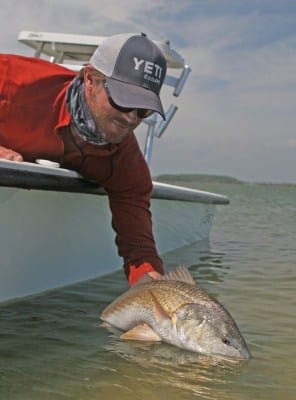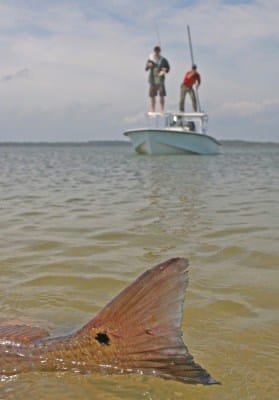
As a guide on South Carolina’s Hilton Head Island, Capt. Brian Vaughn has a wealth of options. So many, in fact, he not only has a hard time choosing which fish he wants to target, but how he wants to target them. Of course, weather and seasons dictate many of his decisions, but there’s no question Vaughn likes to sight-fish for redfish in shallow water when he has the chance.
“It’s so much fun to go out and actually spot a school or an individual redfish and then cast to it and watch a fish move on the lure,” he says. “There are tons of redfish now, and they are really easy to find and catch this time of year.”
On a typical day in late winter, Vaughn’s clients catch a dozen or more reds up to 15 pounds, often from a single school, which can have upwards of 100 fish. He’s had plenty of double-digit days, including a few where two clients boated and released 20 or 25 from just a couple of schools. He’ll pluck a few from one bunch and then go find another after the first school finally gets spooked off a shallow flat.
It’s called sight-fishing, but it might be better to call it fish-hunting. Like a deer hunter who patiently slips through the woods in search of a whitetail, anglers hunting for reds on shallow, clear flats score by watching more and casting less, says Vaughn. The key is to spot a group of fishing gently cruising across a sand bar, a mud flat or an oyster bar and drop a lure right in front of them. If everything goes right, a 10-pounder will smack the lure, usually a gold spoon or a jig, as you pull it through the water. Sometimes, however, things don’t always go as planned.
“The biggest mistake some of my clients make is rushing the cast,” he says.

It’s often a one-chance opportunity: drop the lure in the wrong spot and you’ve likely spooked the fish, although larger schools tend to be more forgiving. Vaughn says the perfect cast should be five to ten feet in front of the fish you are targeting. Too close and the red will likely tear off to deeper water; too far and there’s a good chance the fish will simply turn in a different direction. It takes practice to make accurate casts and it takes even more experience to determine where that fish will be when your lure hits the water. That’s why Vaughn stresses patience. He’ll study the individual fish or the entire school for a minute or so to figure out their next move. Only then will he flick his rod tip and send lure toward the fish.
A bad cast isn’t the only way to blow a chance. Just as a bumbling deer hunter can ruin a shot at a buck, overanxious anglers can also muff an opportunity at a red by making a few more common mistakes.
“Don’t make any noise if you can help it. I use either a trolling motor or a push-pole to get within casting range, and I don’t jump around in the boat or slam any storage lids,” he says. “One wrong move and the fish will head for deeper water.”
The good news is that larger schools will eventually return to that flat, and Vaughn simply tries another location if he does bust a pod of fish. This time of year, redfish stay in the same general location, so Vaughn hits a few of his go-to spots until he finds what he’s looking for.
“They stay within a few hundred yards of where you found them last time,” he says.
You still have to find the fish, which is half the fun of sight-fishing. Once you spot a single redfish or school, your skills as both a hunter and angler will be put to the test.
Sometimes you have to still-hunt. There are times, Vaughn admits, when casting to visible fish simply isn’t an option. Blustery winds, fairly common around Hilton Head in the late winter and early spring, can make spotting schooling reds all but impossible even in shallow water.
“That’s when we fish for them with cut bait or lures in the tidal creeks adjacent to the grass flats,” he says.
Fishing with cut bait may not be as thrilling as stalking reds across flats, but set the hook on a 10-pounder and the fight will be just the same.
For information on a guided trip, contact Vaughn at www.offthehookcharters.com or (843) 298-4376.







